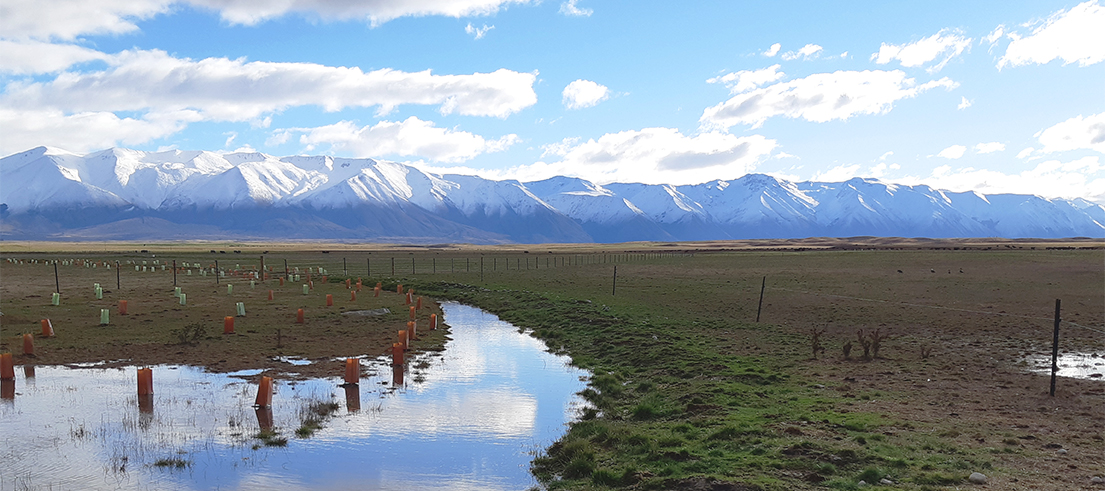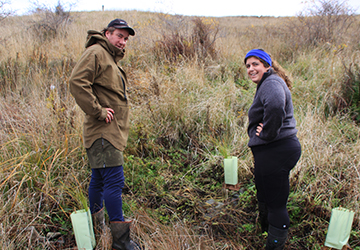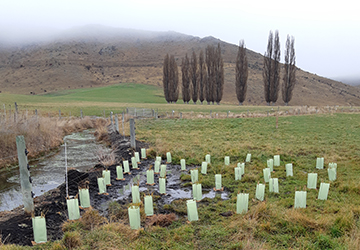
Passionate Twizel farmers push for improved water quality
Farmers around Twizel and Ōmārama are making inroads towards improving the health of local waterways and catchments.
And their cause has now been bolstered by support from Fonterra and Environment Canterbury.
The Spring Creek and the Willow Burn streams, within the Ahuriri catchment, are benefitting from local farmers’ participation in Fonterra’s Sustainable Catchment programme and on the ground support from our staff.
The streams flow through high-country farmland and are fed by the Benmore and Diadem ranges.
At Spring Creek, local dairy farmers have been hard at work planting indigenous riparian vegetation and our staff have played a part in planting more seedlings. Native fish and invertebrates have also been identified in the system previously.
Farmers take water quality improvement upon themselves

Sharemilker Tim Larkins and biodiversity officer Mikaela Farr with the native riparian planting
Sharemilkers Tim and Fleur Larkins manage the dairy farm Spring Creek is located on.
“Fonterra approached us and had the vision for it all, and we already had the area fenced off to keep the stock out, so we pushed it back even further,” Tim said.
“It was good to get involved with this sort of thing. I don’t really have a background in this, but I’d be happy to keep going with these opportunities, it’s good for the environment and it’s an easy process.
“It’s an area that’s always been fenced off so stock couldn’t go near it. So we just pulled the fence even further back and planted that whole area right out too.
“It’s an area that, to look at it, you wouldn’t think there was a stream there. But Ian (Lyttle, ECan land management advisor) pulled out some grass and sure enough, there was quite a bit of flow,” he said.
Long term benefits to carex plantings
At Willow Burn, the project has allowed fencing and planting to occur on three properties in the catchment. Plantings have focused on the use of Carex secta as a shade species to reduce macrophyte water weed growth in the streams.
This has allowed several kilometres of fencing on two properties, with a third property receiving planting and development of small wetlands to remove sediment from the Willow Burn.
The aim of the plantings is to provide edge enhancement to the waterway and to provide extra shading and habitat. Our senior southern land management advisor Ian Lyttle said he was hopeful this was just the start of the project.
“We have, with the help of farm manager Tim and his staff, planted 320 carex with plant guards,” he said.
“In the long term, we hope to see this provide more shade to the waterway, which in turn provides a better and healthier habitat for our flora and fauna to flourish. We love this kind of project and want to see more like it,” Ian said.
Steps being taken to improve ecosystem and catchment health by farmers:

Planting at Buscot Station
- Increasing the riparian buffer from 1-2 metres to over 15m in some parts
- Planted more than 300 native carex with plant guards
- Excluding cattle from waterways on the Willow Burn reaches
- Carex planting providing shade to the catchment.
Fonterra’s Sustainable Catchments supports the Upper Waitaki Water Zone Committee to enhance the water quality, in-stream and riparian values of local streams.
This project aligns with the Committee’s goal to create a health environment, by protecting recreational values and ecosystem health; and enhancing mahinga kai and nohoanga. Ongoing maintenance of the plantings will be carried out by the farmers.
